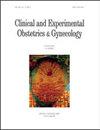Development and Validation of Models to Predict Cesarean Delivery among Low-Risk Nulliparous Women at Term: A Retrospective Study in China
IF 0.6
4区 医学
Q4 OBSTETRICS & GYNECOLOGY
引用次数: 0
Abstract
Background: Intrapartum cesarean delivery has been the focus of many researchers. We derived and validated a model to predict cesarean for low-risk Chinese nulliparous undergoing induction of labor. Methods: We developed a risk model for cesarean by including variables in univariate and multivariable logistic regression using the development set (3841 pregnant women). The performance of the model was assessed for the receiver operating characteristic (ROC) curve, calibration and decision curve analysis (DCA). Additionally, we validated the model externally using an independent dataset (3421 pregnant women). Results: Multivariable logistic regression analysis showed that age, height, body mass index (BMI), weight change during pregnancy, gestational age, premature rupture of membranes (PROM), meconium-stained amniotic fluid and neonatal sex were independent factors affecting cesarean outcome. Two models were established, depending on whether the sex of the fetus was included. The area under the ROC curve of two models were 0.755 and 0.748, respectively. We verified externally, and the area under the ROC curve of two models were 0.758 and 0.758, respectively. The calibration plots demonstrated a good correlation. DCA demonstrated that two models had clinical application value. The online web servers were constructed based on the nomograms for convenient clinical use. Conclusions: These two models can be used as useful tools to assess the risk of cesarean for low-risk Chinese nulliparous undergoing induction of labor.低风险无产妇女足月剖宫产预测模型的建立与验证:中国回顾性研究
背景:产时剖宫产一直是许多研究者关注的焦点。我们推导并验证了一个预测中国低风险无产妇女引产剖宫产的模型。方法:采用发展集(3841例孕妇),通过纳入单因素和多因素logistic回归,建立剖宫产风险模型。通过受试者工作特征(ROC)曲线、校正和决策曲线分析(DCA)对模型的性能进行评估。此外,我们使用独立数据集(3421名孕妇)外部验证了模型。结果:多变量logistic回归分析显示,年龄、身高、体重指数(BMI)、孕期体重变化、胎龄、胎膜早破(PROM)、羊水粪染、新生儿性别是影响剖宫产结局的独立因素。根据是否包括胎儿的性别,建立了两种模型。两种模型的ROC曲线下面积分别为0.755和0.748。经外部验证,两种模型的ROC曲线下面积分别为0.758和0.758。标定图显示出良好的相关性。DCA证明两种模型均具有临床应用价值。为方便临床使用,在此基础上构建了在线web服务器。结论:这两种模型可作为评估中国低危无产妇女引产时剖宫产风险的有效工具。
本文章由计算机程序翻译,如有差异,请以英文原文为准。
求助全文
约1分钟内获得全文
求助全文
来源期刊
CiteScore
0.50
自引率
0.00%
发文量
241
审稿时长
1 months
期刊介绍:
CEOG is an international, peer-reviewed, open access journal. CEOG covers all aspects of Obstetrics and Gynecology, including obstetrics, prenatal diagnosis, maternal-fetal medicine, perinatology, general gynecology, gynecologic oncology, uro-gynecology, reproductive medicine, infertility, reproductive endocrinology, sexual medicine. All submissions of cutting-edge advances of medical research in the area of women''s health worldwide are encouraged.

 求助内容:
求助内容: 应助结果提醒方式:
应助结果提醒方式:


